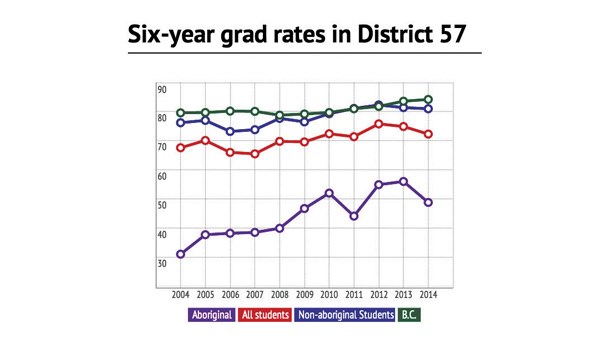Prince George’s six-year graduation rate is more than 10 per cent behind the rest of the province.
The latest numbers from District 57 show 72.3 per cent of its students completed Grade 8 to 12 within six years compared to provincial numbers that sit at 84.2 per cent, according to data the Ministry of Education released in late December.
The local numbers have levelled out in the low 70 per cent range for the last five years, but are up from 67 per cent 10 years ago when the province was reporting 79.7 success rate for students.
Although the numbers aren’t ideal, district superintendent Brian Pepper said the big question for the district is: are we going in the right direction?
“In our case, you can see there’s that upward trend. “We tend to look at, are we improving over time?” said Pepper, adding it’s important not to draw conclusions from year-to-year peaks, or dips, but from long-term trends. “We still have a concern because of course we want to be at or above [the provincial rate].”
A major part of the picture is improving the graduation rates of aboriginal students, said Pepper.
In the last school year, 81 per cent of non-aboriginal students received a Dogwood Diploma, compared to 48.8 per cent for aboriginal students.
That’s down from the previous year’s high of a 56 per cent graduation rate, and up from a low of 31 per cent 10 years ago.
“The gap between aboriginal and all learners needs to continue to close. Our work to continue to improve results is critical,” said Pepper, adding almost one third of the district’s students are aboriginal. The district is made up of Prince George, and stretches south to Hixon, north to Mackenzie, and east to McBride and Valemount.
“We have to work hard to help our six year completion rates for aboriginal learners because the minute you start to close that gap, all results go up,” Pepper said.
Provincially, 61.6 per cent of aboriginal students graduated last year - a number the province said “has improved steadily over the past 10 years” alongside overall graduation rates. The ministry doesn’t provide numbers to compare for non-aboriginal learners.
Some of the district’s success in closing that gap is due to an increased focus over the years on cultural integration.
The school’s district achievement contract, published in July 2014, outlined its goals over three years and identified five learning outcomes for improving success for aboriginal students: culture and language; elders and indigenous knowledge; rediscovery and traditional environmental knowledge; restitution and restorative practice; and youth leadership.
Each school is assigned one outcome and teachers receive focused training. The achievement contract also highlights work by the Aboriginal Education Department to connect with bands and mentorship programs for aboriginal education workers, which act as support staff in all of the district's schools.
“As the five learning “foci” have gained momentum in the district, the graduation rates have steadily increased,” the contract said.
The Ministry of Education’s report also highlighted the jump in results for students with special needs, from 33.4 per cent graduation rate in 2000 and 2001 to 62.2 per cent in the last year.


